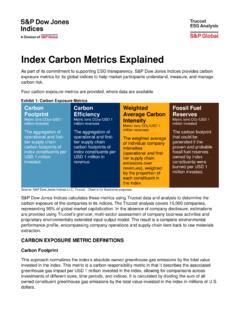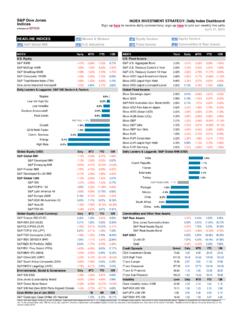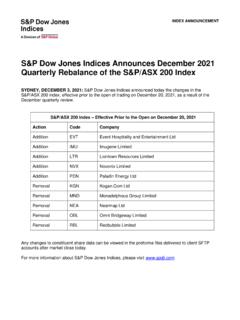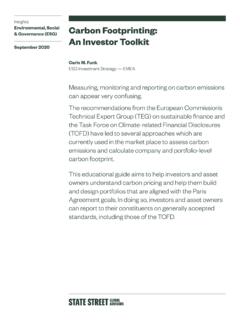Transcription of Industry Top Trends 2020 - S&P Global
1 S&P Global Ratings 1 Industry Top Trends 2020 Telecommunications In the quest for faster networks amid slow growth, financial policy is key What's changed? 5G has launched. 5G services launched, notably in South Korea, the U. S., China, and Switzerland. Indications from South Korea paint an encouraging picture of consumer take-up, but we believe monetization in most countries is less clear cut. A trade war has broken out and economic risks are rising. Telecom companies have exposure to the weakening economy through lower business-to-business revenues, and reduced consumer spending on content, and connected devices. Telcos are taking a break from M&A. Some pending transactions have yet to complete, but we expect more muted M&A in North America and Europe, as companies are digesting previous deals and the pipeline of targets is drying up. What to look out for in the sector in 2020 More 5G launches and spectrum auctions. We look for evidence to gauge consumer demand for 5G, and examples of compelling and commercially ready use cases.
2 However, costly spectrum auctions could add to ratings pressure. Leverage reduction. We expect leverage reduction to be a priority for the sector, with free cash flow being the main driver. However, pressure from shareholders for generous payouts and capital expenditure (capex) remain a risk. Competition may increase risk to credit metrics. Some countries in Asia and Europe have seen new mobile entrants, sometimes encouraged by government policy, and U. S. mobile players are taking on cable with fixed-wireless access. What are the key medium-term credit drivers? The challenge of cashing in on data growth. Monetizing explosive data growth--through tiered pricing in mobile, the up-selling of higher broadband speeds, and new industrial use cases--remains the sector's pivotal challenge. The need to deliver on past M&A. companies ' ability to integrate acquisitions and deliver promised synergies will be key to sustaining credit metrics and ratings. The continued expansion of over-the-top (OTT) options.
3 Fragmented direct-to-consumer content propositions could allow cable to reestablish itself as an aggregator, but profitability from this is weak relative to historical levels. November 21, 2019 Authors Lukas Paul Frankfurt +49 69 33999 132 @ Mark Habib Paris +33 1 4420 6736 @ Allyn Arden, CFA New York +1 212 438 7832 @ JunHong Park Hong Kong +852 2533 3538 @ Luis Manuel Martinez Mexico City +52 55 5081 4462 @ Chris Mooney, CFA New York +1 212 438 4240 @ Saha-Yannopoulos, Aniki New York +1 212 438 4240 Industry Top Trends 2020: Telecommunications S&P Global Ratings November 21, 2019 2 Ratings Trends and outlook Global Telecommunications Chart 1 Chart 2 Ratings distribution Ratings distribution by region Chart 3 Chart 4 Ratings outlooks Ratings outlooks by region Chart 5 Chart 6 Ratings outlook net bias Ratings net outlook bias by region Source: S&P Global Ratings. Ratings data measured at quarter end. Data for Q4 2019 is end October, 2019 We expect stable ratings for most issuers in the sector globally, but the outlook bias has turned more negative over the past 12 months across all regions.
4 This is apparent in Asia-Pacific (APAC), where some issuers are confronted with increased competitive pressure, and in Latin America, where some issuers are facing sovereign-related rating constraints and macroeconomic headwinds. In North America, ratings pressure remains centered on wireline, where a secular decline persists, and on data center segments, where the shift to the cloud has slowed colocation growth and hurt margins for smaller , highly leveraged operators. Industry Top Trends 2020: Telecommunications S&P Global Ratings November 21, 2019 3 North America Rating Trends in the were largely negative in 2019, with 19 downgrades and only three upgrades. We expect the negative rating trend to continue, as more than 20% of rated issuers either have a negative outlook or are on CreditWatch negative. We expect rating Trends in cable to be relatively stable as broadband growth offset the loss of lower-margin video customers. Ratings pressure could come from secular Industry declines in wireline; integration missteps in acquisitions among data center and fiber providers; and slowing growth.
5 Ratings Trends in Canada, however, remain stable given the rational competition among the national telecom players. Improving Trends for regional wireless players and constructive broadband Trends continue to support ratings stability among the smaller operators. Europe We expect stable ratings for the vast majority of issuers in Europe. With less than 15% of ratings on negative outlook or CreditWatch negative, Europe has a more balanced mix of outlooks than the other regions, and the highest percentage of stable outlooks, at over 80%. Although competition remains intense in many markets, most regulatory headwinds for telecom pricing have now abated, and companies ' credit metrics should see some improvements from continued cost-saving efforts. In some cases, further support may come from leverage-reduction measures such as disposals, for example, of tower assets. We also have stable outlooks on most cable companies . We expect cable companies to display faster revenue and EBITDA growth than telcos, albeit accompanied by higher capex intensity.
6 However, capex intensity should moderate as larger network upgrades approach completion. We think these factors will provide cable companies with greater organic deleveraging capacity than telcos. Latin America The region's net negative outlook bias is at about 20%, while stable outlooks are close to 80%. Political uncertainty and expectations for weaker economic growth across the region in 2020 could negatively weigh on credit metrics over the next 12 months, and exacerbate downside risks on ratings. In 2019, the outlook revision to negative on the sovereign ratings of Mexico and Argentina also triggered similar rating actions on some operators from those two countries. Yet, stable outlooks on the vast majority of issuers reflects resilient operating performance, supported by still-healthy demand in the wireless subscriber base, fixed-line broadband access, and mobile data usage. Asia-Pacific We are seeing gradually increasing downward pressure on APAC telcos' creditworthiness, with a negative outlook bias of over 20%.
7 This is mainly attributable to stiff competition and ongoing large capital spending needs for advanced network deployment in many APAC markets. Despite growing data consumption, competition remains intense, with deeper cuts in wireless tariff pricing in India, Australia, Singapore, Japan, and Taiwan. Industry Top Trends 2020: Telecommunications S&P Global Ratings November 21, 2019 4 Global Telecoms Key assumptions 1. No end in sight for data consumption growth, but telcos ability to cash in remains uncertain We think mobile and fixed data growth will continue apace, but operators' ability to convert this into incremental revenue is still uncertain. This could change in the medium term as high data consumption may put a premium on network quality. 2. Fixed-mobile convergence will increase, but at an uneven pace We believe that convergence will ultimately conquer most European and some Asian telecom markets, but the future of convergence in the U. S. and Latin America is less clear cut, partly because of fewer integrated operators in these markets.
8 3. High capex is here to stay Global capex will remain high, driven by 5G-related spending on spectrum, site expansion, and fiber backhaul. This is in addition to ongoing high investments in fixed broadband networks to replace copper with fiber in regions such as Europe and Latin America. The Industry is heading for modest growth and leverage improvements in 2020 We expect the Global telecom and cable Industry to show low-single-digit revenue growth and modest improvements in profitability in 2020. For telcos, growth mainly relies on still-rising mobile and broadband penetration in some regions, and the up-selling of mobile data and broadband in certain countries. Cable operators should continue to grow faster than telcos, mainly thanks to broadband, but growth continues to slow down as a result of pressure on TV revenues. We expect all players to maintain focus on costs, supporting a very gradual expansion of EBITDA margins. The combination of cost-cutting and leverage reduction through free cash flow should help to support a modest reduction of S&P Global Ratings-adjusted debt to EBITDA next year.
9 No end in sight for data consumption growth We expect demand for data will continue to grow strongly, both in mobile and fixed networks, forcing operators to maintain high network investments despite mixed prospects for monetization. While unlimited data is prevalent in fixed plans, speed tiering and regular price increases have allowed for some monetization of data growth. In mobile, the success of more-for-more strategies involving migration to larger data allowances have varied by market. We believe intense competition has increased the commoditization of data, as evident from more unlimited plans, as has the ability to offload to Wi-Fi. In consumer markets, video will remain the pivotal growth driver, with surging consumption of streaming or on-demand services, the proliferation of online and mobile gaming, improved resolution of existing video-based content, and, further down the line, augmented and virtual reality applications. We think these Trends will initially benefit fixed-line consumption where we see the bulk of consumption and device proliferation occurring.
10 This could be good news for cable operators in areas where they compete with copper-based infrastructure due to the superior headline speeds of cable networks. However, fiber investments by telcos will continue to reduce this advantage in the medium-to-long term. Industry Top Trends 2020: Telecommunications S&P Global Ratings November 21, 2019 5 In the medium term, businesses of all sizes will contribute increasingly to mobile data growth as they move toward digitization, such as through smart factories in manufacturing, intelligent fleet management in logistics, or smart metering and grid management by utilities. Network equipment vendor Ericsson estimates that mobile data traffic will grow at a compound annual rate of 30% over 2018-2024. While mobile operators have struggled to convert data consumption into revenue growth, many are counting on increases in 5G-reliant devices, and that speeds ten times faster than 4G will drive a step-change in consumption that will finally deliver on the more-for-more promise.
















